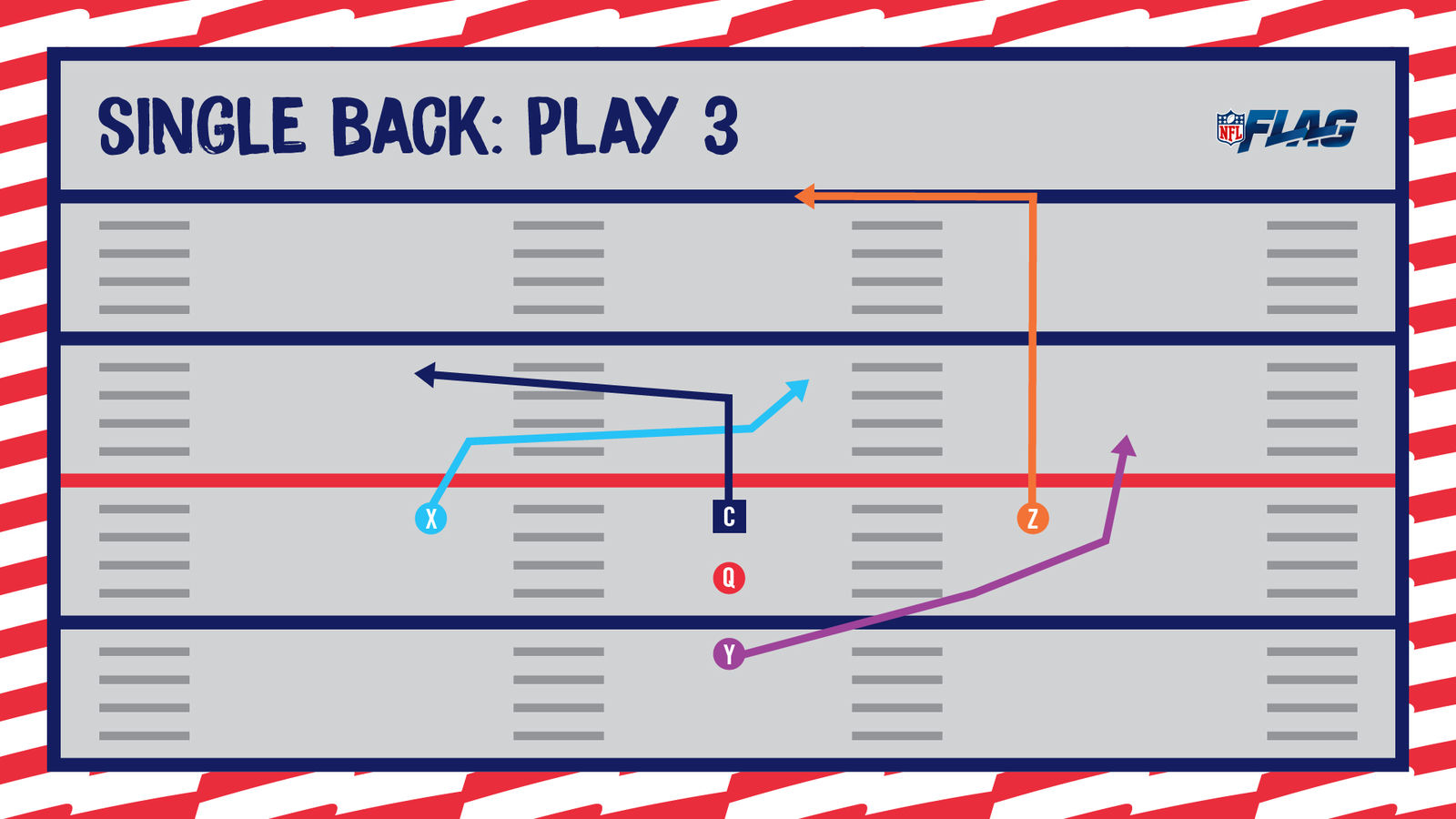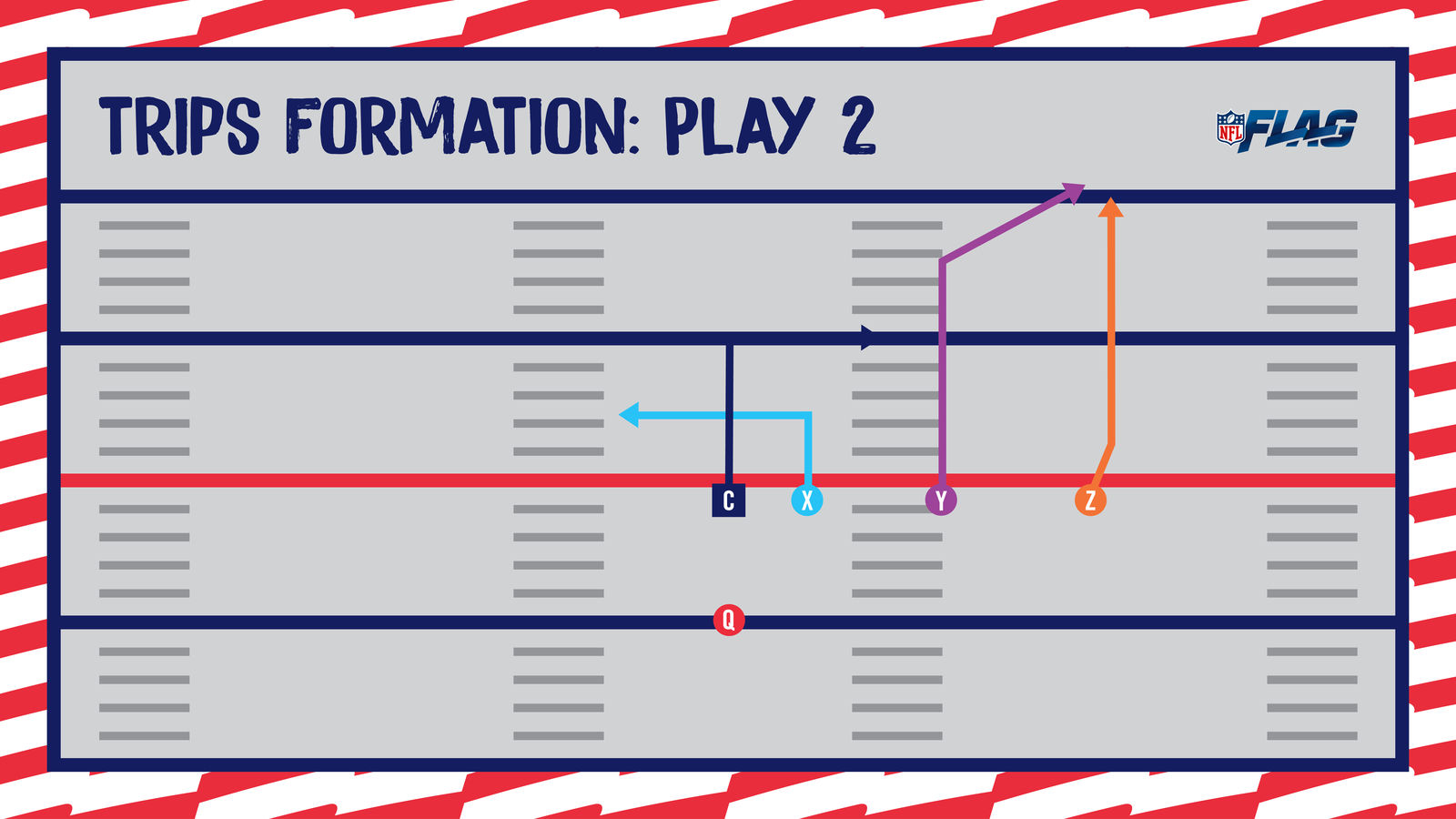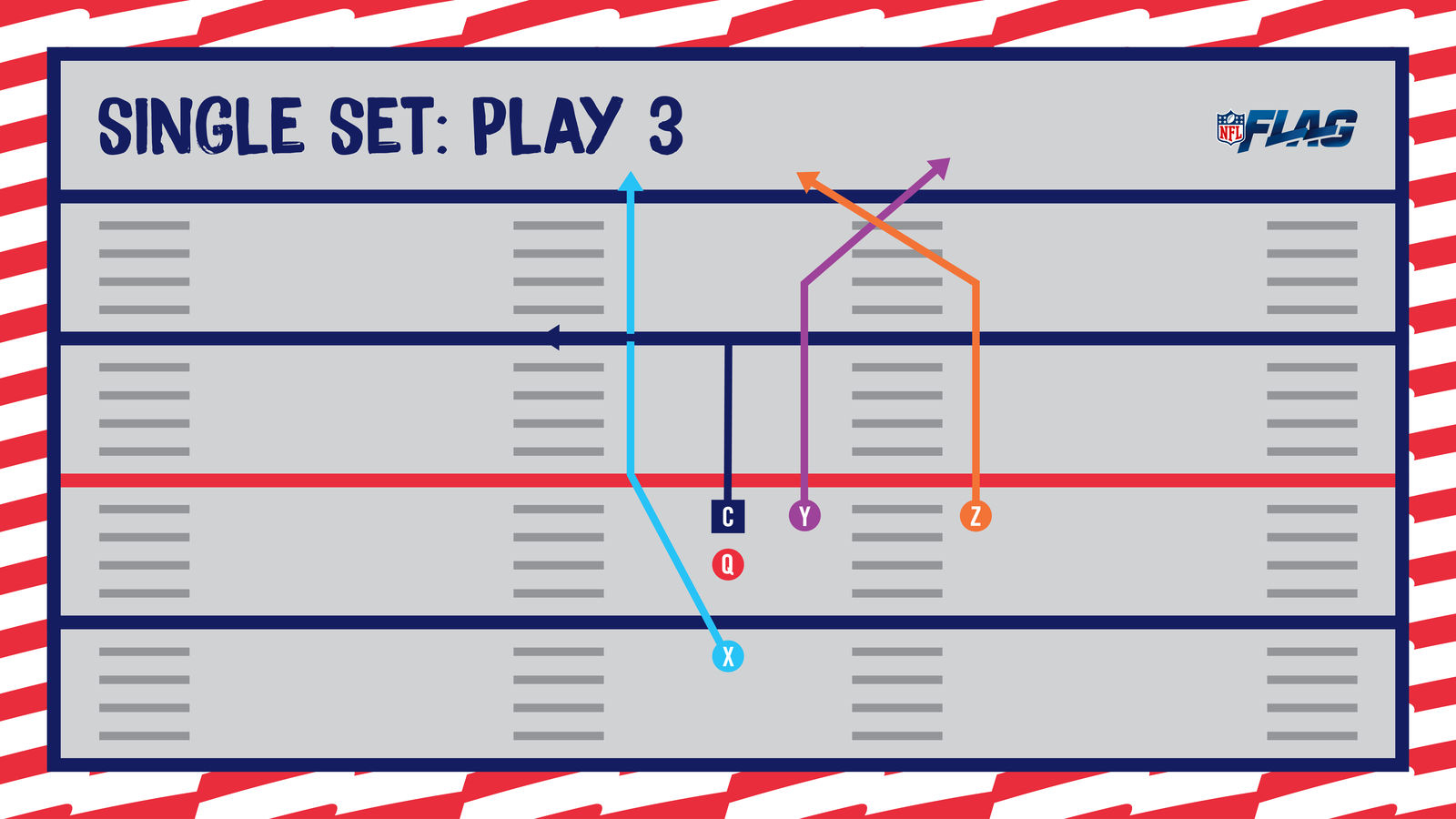FLAG FOOTBALL PLAYS AND FORMATIONS
Discover the best flag football plays—and use our basic guide to create some of your own.
You’ve bought the cleats, prepped your flags, and now it’s time to equip yourself, and your team, with flag football plays and formations for your upcoming season.
To set up flag football teams for success, we put together a guide that prepares all levels of players. Whether this is your first season coaching, or you’re coming back for your tenth championship, our flag football plays and formations outline will provide a strong foundation for your team.
Quick Links: Football formations | Best flag football routes | Best flag football plays | 5 on 5 flag football plays | 7 on 7 flag football plays
FOOTBALL FORMATIONS
We recommend beginning coaching with a strong set of fundamentals before conquering complex setups. Some of the best football plays are actually quite simple. That’s why our guide provides needed information—from basics to more advanced football formations—for both 5 on 5 and 7 on 7 flag football plays.
What is a football formation? At the beginning of all offensive plays, players on the field must create an offensive formation at the line of scrimmage. Football formations give each player a specific location on the line of scrimmage to begin their play. This prevents players from running into each other, crowding on the field, and promotes safety.
Take a look at the offensive flag football plays below. Each circle or O represents an individual player, with the square representing the quarterback. Where each player is located at the start of the play represents an offensive formation. The arrows reflect the plays, or routes, which provide an individualized map for each player in a formation.
BEST FLAG FOOTBALL ROUTES
You want to score some touchdowns, right? Let’s dive into individual routes that will give you enough knowledge and context to create new, slick flag football plays of your own.

NFL FLAG ROUTE TREE

This image showcases six different routes that can be used on offense in flag football.
Let’s walk through each player, from left to right. Note that all routes begin at the hike of the ball by the quarterback.
0 - Hitch: In this hitch route, the player runs straight for seven yards, then quickly pivots backwards for a couple yards. This throws off defenders running backwards to guard the player, and opens them up to a quick pass from the quarterback.
1 - Slant: During a slant, the player should run forward a couple yards, then cut at a near 45-degree angle forward. This play becomes more effective when combined with 2 - Out (See below).
2 - Out: In an out play, the player should run forward for a designated yardage, five in this case, and then cut on a direct 90-degree angle in either direction.
Offensive football plays pro-tip: The combination of 1-Slant and 2-Out is a classic, effective technique. As the two players cross directions mid-route, their defensive counterparts are often unable to track and follow their designated target. This opens not one, but two players for a quick throw from the quarterback. Your first down awaits!
Offensive football plays safety pro-tip: When combining two football plays that cross each other, like slants and outs, make sure the players communicate who is going to leave their formation first. This prevents any collisions as the players complete their routes.
3 - Post: The player runs forward a designated amount, in this case seven yards, then cuts at a 45-degree angle to the center of the field. This route is reliable for critical yardage gain.
Offensive football plays pro-tip: Having a hard time keeping all the types of routes straight? Easily remember ‘post’ routes by envisioning that you’re running towards the field goal post in the center of the field.
4 - Corner: This player proceeds straight for seven yards, then runs at a 45-degree angle toward the edge of the field. This route is optimal if you need the player to catch the ball and then step out of bounds to stop the clock during a nail-biting game.
5 - Fly: The fly is the easiest route in the book. Run straight—and fast! Give this route to the player who has some serious wheels (and hands) to gain lots of yardage. First down!
NFL FLAG ROUTE TREE

Now let’s go over some more complicated routes showcased in the image above and walk through each individual player’s movement.
6 - Option: In this trick route, the player appears to begin a slant, heading toward the center of the field, but then cuts directly parallel toward the sideline. This is effective for needed short yardage.
7 - Stop and Go: This route is perfect for players who have a need for speed. First, they run straight about seven yards and then stop. Just when the designated defensive guard thinks they’re covered, the player takes off again toward the end zone. Catch that ball and they’re home free.
8 - Post Corner: This route mixes the magic of a post route with—you guessed it—a corner route. This player runs straight for seven yards, then cuts toward the center of the field. Once their guard is still, they break out toward the corner of the field.
9 - Chair: This player runs forward about four yards, then cuts parallel to the side of the field. Instead of stopping like an out route, they shoot straight up the field toward the end zone. These two back-to-back cuts leave defensive guards in the dust.
You can mix and match these routes to create your own custom flag football plays, which can be used in 5 on 5 flag football, 7 on 7 flag football, and even more advanced leagues.
BEST FLAG FOOTBALL PLAYS
Now that you know all the individual routes that make up a flag football play, let’s go over a few of the best flag football plays. Note that the plays shown are set up for 5 on 5, but can easily be adapted to other variations or levels.

Single-Back Criss-Cross - In this play, two receivers start at the line of scrimmage, equal lengths apart. An additional receiver starts a couple yards behind the quarterback.
Upon the snap, the center and the left receiver perform reverse slants, slightly staggered. This cuts off their respective defensive guards, opening them up for quick yardage.
The receiver on the right side of the quarterback performs an in route (opposite of an out route), at about 10 yards. It’s recommended to throw to this receiver if a first down is needed or the receiver is wide open.
Lastly, the receiver stacked behind the quarterback runs toward the outside of the field and up the field. Because this receiver is stacked behind the line of scrimmage, it allows more time for the player to get open before they are met by their respective defensive guard.

Trips Right - Notice that one side of the field has a defensive blindspot? It’s time to break out the triple, or ‘trips,’ formations. Trips plays can be used on either side of the quarterback and are designed to expose defensive weaknesses and cause confusion, making it one of the best youth flag football plays to unleash.
For this football play, we will stack the three receivers on the right side of the quarterback.
The receiver starting farthest right does a slight slant and then flies up the field, spreading out the defensive line. Meanwhile, the middle receiver performs a corner to further spread out the defense.
The inside receiver and center then do a crossing in and out, twisting up the remaining defensive players. Because of the misdirection of these two players, often one of them will remain open for some short, quick yardage while the defensive line readjusts to the scramble.

Single-Set Right Cross- Are you down by five with only 15 seconds left on the clock? Here’s the perfect football play to score some heavy yardage.
Have two receivers line up to the right of the quarterback, and the last receiver a few yards behind the quarterback. Upon the hike, the two receivers on the right perform a seven yard corner and a seven yard post, respectively. This cross throws off defenders and should leave you with two receivers open over 10 yards deep.
Safety pro-tip: Make sure to designate which player crosses first—you don’t want any team members bumping heads.
The remaining receiver behind the quarterback will start the route in a slant, then break off into a fly at the line of scrimmage. Perfect for a final hail mary!
If none of these routes leave receivers open, the center can release and do a five yard out. This is a quick release, resulting in slightly less yardage, but still a solid backup plan.
5 ON 5 FLAG FOOTBALL PLAYS
Traditional flag football leagues participate in 5 on 5 play. On offense, this typically consists of:
-
One quarterback: This player is given the ball at the start of the play and aims to throw the ball to an open receiver or the center. Because there are no linemen, you’ll find most 5 on 5 teams use football pass plays.
-
One center: This player hands the ball to the quarterback at the start of the play. They can then either guard the quarterback to allow more time for the quarterback to throw the ball, or release and run a route, similar to a receiver.
-
Three receivers: These players run designated routes to open themselves up for a pass from the quarterback.
For each offensive play, the individual players line up on the line of scrimmage. Each player then performs a running route. The combination of each of these routes make up a play. Mixing and matching the nine different route types and field positions allows for hundreds of unique plays. However, it is highly recommended that your team prepare a shortlist of preferred flag football plays ahead of the game. This will allow for quicker decisions in between downs and less confusion on the field.
Need a little bit of help crafting football excellence? Check out the complete 5 on 5 NFL FLAG Playbook.
7 ON 7 FLAG FOOTBALL PLAYS & FORMATIONS
While most leagues play 5 on 5 flag football, including all NFL FLAG teams, you may encounter a league that plays 7 on 7 flag football. This often includes adult competitive leagues, regional recreation leagues, and co-ed leagues.
There are several benefits of having 7 on 7 flag football play:
-
Allows for more players to play at once
-
Opens up additional possibilities for play formations
-
Allows mixing of player skill levels
-
Opportunity for more quarterback running plays
When building out 7 on 7 flag football plays, you can build off of existing 5 on 5 flag football plays, such as those in our NFL FLAG 5 on 5 Playbook.
However, in typical 7 on 7 play, there is an additional offensive player role. Often one of the seven players now plays as a lineman, whose role is to guard the quarterback from getting their flag pulled during the play.
Safety pro-tip: It is important to note that in all 7 on 7 play the linesman position is a non-violent role. Rules range from league to league, but tackling is never acceptable in this role.
The remaining additional player often plays as a receiver. This allows for there to be a total of four receivers, often split on either side of the quarterback. The two receivers closest to the quarterback are called ‘slot receivers’ and the two further receivers are known as ‘wide receivers.’
7 of 7 flag football often has the same rules as 5 on 5 flag football offensive play, but consult with your league for further rules and information.